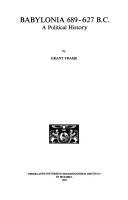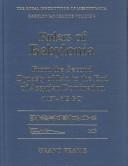| Listing 1 - 10 of 20 | << page >> |
Sort by
|
Book
ISBN: 9783980846677 3980846679 Year: 2013 Volume: 5 Publisher: Dresden : ISLET,
Abstract | Keywords | Export | Availability | Bookmark
 Loading...
Loading...Choose an application
- Reference Manager
- EndNote
- RefWorks (Direct export to RefWorks)

ISBN: 9062580696 Year: 1992 Publisher: Istanbul : Nederlands historisch-archaeologisch Instituut te Istanbul,
Abstract | Keywords | Export | Availability | Bookmark
 Loading...
Loading...Choose an application
- Reference Manager
- EndNote
- RefWorks (Direct export to RefWorks)
935.4 --- Geschiedenis van Babylonië --- Babylonia --- -Politics and government --- Politics and government. --- 935.4 Geschiedenis van Babylonië --- -Vavilonii︠a︡ --- Bavel --- Bābil --- Babylonien --- Politics and government --- Vavilonii︠a︡ --- Sumer

ISBN: 0802007244 1442623748 1442657057 9781442657052 9781442623743 9781442623743 Year: 1995 Volume: 2 Publisher: Toronto
Abstract | Keywords | Export | Availability | Bookmark
 Loading...
Loading...Choose an application
- Reference Manager
- EndNote
- RefWorks (Direct export to RefWorks)
Annotation
Babylone --- -Babylonia --- Vavilonii︠a︡ --- Bavel --- Bābil --- Babylonien --- Cuneiform inscriptions, Akkadian. --- Akkadian language --- Akkadian cuneiform inscriptions --- Babylonia --- Kings and rulers. --- History --- Histoire --- -Cuneiform inscriptions, Akkadian --- Accadian language --- Assyrian language --- Assyro-Babylonian language --- Babylonian language --- Texts --- -Vavilonii︠a︡ --- -Sources --- Kings and rulers --- Cuneiform inscriptions, Akkadian --- Akkadien (Langue) --- Inscriptions cunéiformes akkadiennes --- Textes --- Babylonie --- Sources --- Rois et souverains --- Sumer --- Sources.
Book
ISBN: 9780802007247 Year: 1995 Publisher: Toronto : University of Toronto press,
Abstract | Keywords | Export | Availability | Bookmark
 Loading...
Loading...Choose an application
- Reference Manager
- EndNote
- RefWorks (Direct export to RefWorks)
Akkadian language --- Akkadian language. --- Akkadien (Langue) --- Akkadien (langue) --- Cuneiform inscriptions, Akkadian. --- Cuneiform inscriptions, Akkadian. --- Inschrift. --- Inscriptions cunéiformes akkadiennes. --- Inscriptions cunéiformes akkadiennes. --- Kings and rulers. --- Rois et souverains --- Rois et souverains --- Textes. --- Textes. --- Geschichte 1157 v. Chr.-612 v. Chr. --- Assyrie --- Babylone --- Babylonia --- Babylonia --- Babylonie --- Babylonien. --- Middle East --- Rois et souverains --- Sources. --- Histoire --- Sources. --- History --- Kings and rulers. --- Rois et souverains --- Sources.
Book
Year: 2013 Publisher: Dresden Islet
Abstract | Keywords | Export | Availability | Bookmark
 Loading...
Loading...Choose an application
- Reference Manager
- EndNote
- RefWorks (Direct export to RefWorks)
The Mušēzib-Marduk archive provides an interesting view of an individual's activities in Babylonia while that land lay under Assyrian domination, a period for which few other private archives of any size are attested in Babylonia. Although the transactions took place at eight or nine different locations, most come from Uruk and, to a lesser extent, Babylon. Mušēzib-Marduk's activities date from 678 until at least 649 (a career of at least forty-five years). It is likely that the political events of the period, in particular the rebellion of 652-648 led by Šamaš-šuma-ukīn, influenced his actions, and the end of the archive may have been connected to the collapse of Assyrian control in southern Babylonia. Although he seems to have spent most of his active career at Uruk, he may have been based at Babylon in the years immediately before the rebellion. Mušēzib-Marduk was no common citizen. He appears conducting business in at least five other locations in addition to Uruk.
Akkadian language --- Mušēzib-Marduk, --- Erech (Extinct city) --- Commerce
Book
Year: 1992 Publisher: Istanbul : Nederlands Historisch-Archaeologisch Instituut te Istanbul,
Abstract | Keywords | Export | Availability | Bookmark
 Loading...
Loading...Choose an application
- Reference Manager
- EndNote
- RefWorks (Direct export to RefWorks)
Book
ISBN: 9781646021499 1646021495 9781646021093 1646021096 Year: 2020 Publisher: University Park, PA
Abstract | Keywords | Export | Availability | Bookmark
 Loading...
Loading...Choose an application
- Reference Manager
- EndNote
- RefWorks (Direct export to RefWorks)
Article
Abstract | Keywords | Export | Availability | Bookmark
 Loading...
Loading...Choose an application
- Reference Manager
- EndNote
- RefWorks (Direct export to RefWorks)
Book
ISBN: 9781646021093 1646021096 Year: 2021 Volume: 2 Publisher: University Park, Pennsylvania : Eisenbrauns,
Abstract | Keywords | Export | Availability | Bookmark
 Loading...
Loading...Choose an application
- Reference Manager
- EndNote
- RefWorks (Direct export to RefWorks)
"A collection of English translations of all the official inscriptions of Sargon II, king of Assyria (721-705 BC), as well as those of his wife and officials"
Cuneiform inscriptions, Akkadian --- Cuneiform inscriptions, Sumerian --- Akkadian language --- Sumerian language --- Translations into English --- Sargon --- Assyria --- History --- Kings and rulers --- Cuneiform inscriptions, Akkadian. --- Cuneiform inscriptions, Sumerian. --- Akkadian language. --- Kings and rulers. --- Sumerian language. --- Middle East --- Akkadian language - Translations into English --- Sumerian language - Texts --- Sargon - II, - King of Assyria --- Assyria - History - Sources --- Assyria - Kings and rulers
Book
ISBN: 1646021495 Year: 2021 Publisher: University Park, Pennsylvania : Eisenbrauns,
Abstract | Keywords | Export | Availability | Bookmark
 Loading...
Loading...Choose an application
- Reference Manager
- EndNote
- RefWorks (Direct export to RefWorks)
The Neo-Assyrian king Sargon II was one of the most important and famous rulers of ancient Mesopotamia. In this volume of critically important ancient documents, Grant Frame presents reliable, updated editions of Sargon’s approximately 130 historical inscriptions, as well as several from his wife, his brother, and other high officials.Beginning with a thorough introduction to the reign of Sargon II and an overview of the previous scholarship on his inscriptions, this modern scholarly edition contains the entire extant corpus. It presents more than 130 inscriptions, preserved on stone wall slabs from his palace, paving slabs, colossi, steles, prisms, cylinders, bricks, metal, and other objects, along with brief introductions, commentaries, comprehensive bibliographies, accurate transliterations, and elegant English translations of the Akkadian texts. This monumental work is complemented by more than two dozen photographs of the inscribed objects; indices of museum and excavation numbers, selected publications, and proper names; and translations of relevant passages from several other Akkadian texts, including chronicles and king lists.Informed by advances in the study of the Akkadian language and featuring more than twice as many texts as previous editions of Sargon II’s inscriptions, this will be the editio princeps for Assyriologists and students of the Sargonic inscriptions for decades to come.
Sargon --- Assyria --- History --- Kings and rulers. --- Akkadian. --- Assyria. --- Cuneiform. --- Khorsabad. --- Royal Inscriptions. --- Sargon.
| Listing 1 - 10 of 20 | << page >> |
Sort by
|

 Search
Search Feedback
Feedback About UniCat
About UniCat  Help
Help News
News